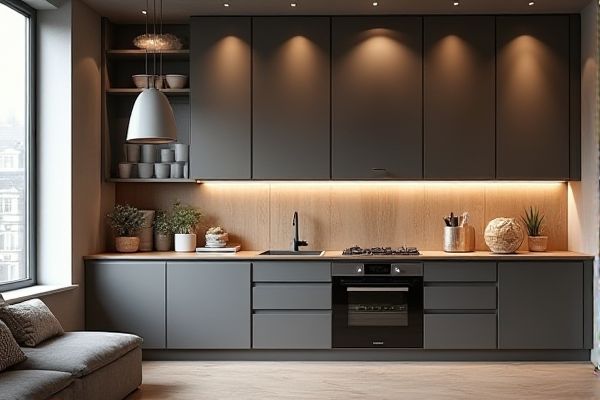
Steel cabinets offer superior durability, resistance to moisture and pests, and a modern aesthetic compared to wooden cabinets, which provide warmth, natural beauty, and customizable finishes. Discover which cabinet type best suits Your storage needs and style preferences by exploring the detailed comparison in this article.
Table of Comparison
| Feature | Steel Cabinets | Wooden Cabinets |
|---|---|---|
| Durability | High resistance to wear, rust-resistant if coated | Prone to scratches, dents, and moisture damage |
| Weight | Heavier and robust | Lighter and easier to move |
| Maintenance | Low maintenance, easy to clean with damp cloth | Requires regular polishing and protection from moisture |
| Design Flexibility | Limited styles, usually industrial look | Wide variety of styles, finishes, and customization |
| Cost | Generally more affordable | Usually higher priced, depending on type of wood |
| Environmental Impact | Recyclable, made from steel | Biodegradable, renewable resource |
| Fire Resistance | Highly fire-resistant | Combustible material, lower fire resistance |
| Usage | Ideal for heavy-duty, industrial, or office storage | Preferred for home, aesthetic, and furniture purposes |
Introduction: Steel Cabinets vs Wooden Cabinets
Steel cabinets offer superior durability, resistance to moisture, and enhanced security compared to wooden cabinets, making them ideal for industrial and commercial use. Wooden cabinets provide a classic aesthetic appeal, natural warmth, and easier customization options, preferred in residential and traditional settings. Choosing between steel and wooden cabinets depends on factors like environmental conditions, design preferences, and intended usage.
Material Composition and Properties
Steel cabinets are constructed from durable metal alloys such as galvanized or stainless steel, providing high resistance to corrosion, fire, and physical impact. Wooden cabinets, typically made from solid wood or engineered wood products like MDF or plywood, offer natural aesthetics and moderate structural strength but are prone to moisture damage and insect infestation. The superior tensile strength and non-combustible nature of steel enhance its longevity and security compared to the organic composition and vulnerability of wood materials.
Durability and Longevity Comparison
Steel cabinets outperform wooden cabinets in durability and longevity due to their resistance to moisture, pests, and warping. While wooden cabinets may show signs of wear over time, steel options maintain structural integrity in harsh environments and heavy-use scenarios. Choosing steel cabinets enhances the lifespan of your storage solution, ensuring consistent performance and minimal maintenance.
Aesthetic and Design Flexibility
Steel cabinets offer a sleek, modern aesthetic with clean lines and a variety of finishes, making them ideal for contemporary or industrial-inspired spaces. Wooden cabinets provide unmatched design flexibility through diverse wood types, stains, and custom carvings, allowing for a warm, classic, or rustic appearance that can be tailored to your personal style. Choosing between steel and wooden cabinets depends on your desired balance between durability and the customizable, timeless beauty wood offers.
Maintenance and Cleaning Requirements
Steel cabinets require minimal maintenance, as they resist stains, corrosion, and moisture, allowing for easy cleaning with mild detergents and water. Wooden cabinets demand more care to prevent damage from humidity, requiring regular polishing and wiping with specialized wood cleaners to maintain their finish. Your choice impacts long-term upkeep, with steel offering durability and low-maintenance benefits compared to the delicate care wooden cabinets need.
Cost Analysis and Budget Considerations
Steel cabinets typically offer a lower initial cost compared to wooden cabinets, making them a budget-friendly option for commercial and industrial settings. Maintenance expenses are also reduced with steel due to its durability, resistance to pests, and ease of cleaning, while wooden cabinets may require regular refinishing or repairs. Long-term budget considerations favor steel cabinets for environments needing high durability and low upkeep, whereas wooden cabinets might suit aesthetic preferences but incur higher maintenance costs.
Environmental Impact and Sustainability
Steel cabinets are highly recyclable, often containing a significant percentage of recycled material, which reduces the demand for virgin resources and lowers the environmental footprint. Wooden cabinets, if sourced from sustainably managed forests certified by organizations like FSC, offer a renewable material option but may involve higher carbon emissions due to logging and transportation processes. Choosing steel cabinets supports long-term sustainability through durability and recyclability, whereas wooden cabinets require careful sourcing and maintenance to ensure eco-friendly benefits.
Security and Safety Features
Steel cabinets offer superior security with their robust, tamper-resistant construction and reinforced locking mechanisms, making them ideal for storing sensitive documents or valuable items. Wooden cabinets, while aesthetically pleasing, generally provide less protection against break-ins, fire, and pests compared to steel options. Choosing steel cabinets enhances Your safety by reducing risks of unauthorized access and damage from environmental hazards.
Popular Applications and Use Cases
Steel cabinets are widely used in industrial, medical, and office environments due to their durability, fire resistance, and ease of cleaning. Wooden cabinets are often preferred in residential settings and boutique retail spaces for their aesthetic appeal and customization options. Your choice depends on the environment's requirement for strength, hygiene, and design.
Final Verdict: Choosing the Right Cabinet for Your Needs
Steel cabinets offer superior durability, resistance to moisture, and modern aesthetics, making them ideal for industrial or high-usage environments. Wooden cabinets provide a classic, warm appearance with customization options but require more maintenance and are susceptible to damage from humidity and pests. Your choice should balance the need for longevity and style with the environment where the cabinet will be used, ensuring the right fit for your storage requirements.
 homyna.com
homyna.com